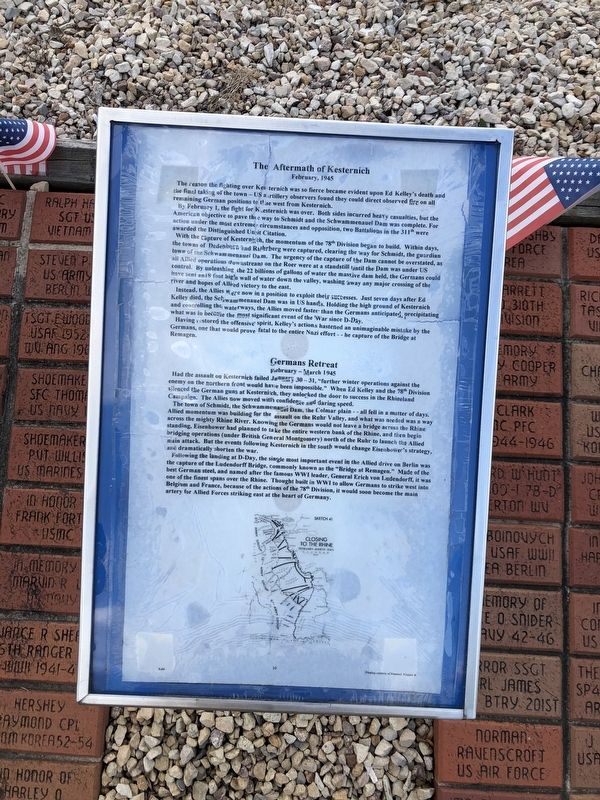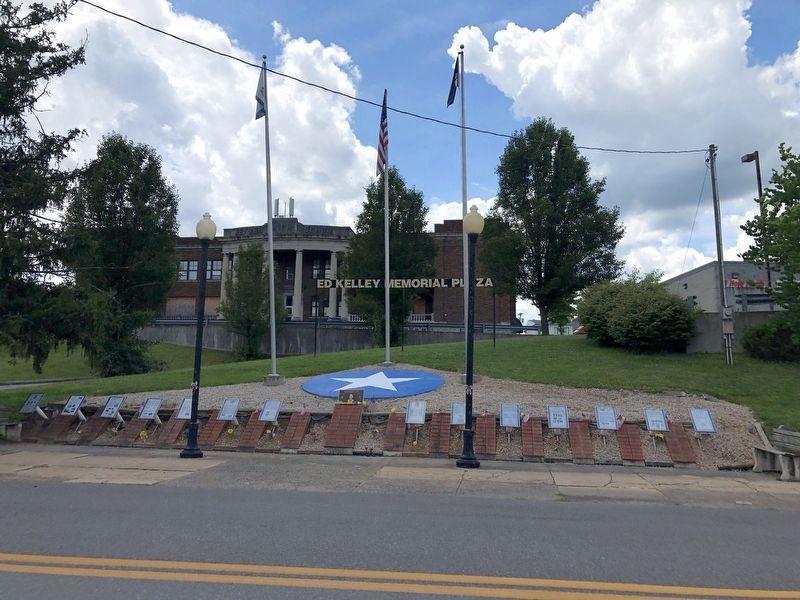Keyser in Mineral County, West Virginia — The American South (Appalachia)
The Aftermath of Kesternich / Germans Retreat

Photographed By Devry Becker Jones (CC0), July 12, 2020
1. The Aftermath of Kesternich / Germans Retreat Marker
February, 1945
The reason for fighting over Kesternich was so fierce became evident upon Ed Kelley's death and the final taking of the town — US artillery observers found they could direct observed fire on all remaining German positions to the west from Kesternich.
By February 1, the fight for Kesternich was over. Both sides incurred heavy casualties, but the American objective to pave the way to Schmidt and the Schwammenauel Dam was complete. For action under the most extreme circumstances and opposition, two Battalions in the 311th were awarded the Distinguished Unit Citation.
With the capture of Kesternich, the momentum of the 78th Division began to build. Within days, the towns of Dedenborn and Ruhrberg were captured, clearing the way for Schmidt, the guardian town of the Schwammenauel Dam. The urgency of the capture of the Dam cannot be overstated as all Allied operations downstream on the Roer were at a standstill until the Dam was under US control. By unleashing the 22 billions of gallons of water the massive dam held, the Germans could have sent an 18 foot high wall of water down the valley, washing away any major crossing of the river and hopes of Allied victory to the east.
Instead, the Allies were now in a position to exploit their successes. Just seven days after Ed Kelley died, the Schwammenauel Dam was in US hands. Holding the high ground of Kesternich and controlling the waterways, the Allies moved faster than the Germans anticipated, precipitating what was to become the most significant event of the War since D-Day.
Having restored the offensive spirit, Kelley's actions hastened an unimaginable mistake by the Germans, one that would prove fatal to the entire Nazi effort - - he capture of the Bridge at Remagen.
February - March, 1945
Had the assault on Kesternich failed January 30 - 31, "further winter operations against the enemy on the northern front would have been impossible." When Ed Kelley and the 78th Division silenced the German guns at Kesternich, the unlocked the door to success in the Rhineland Campaign. The Allies now moved with confidence and daring speed.
The town of Schmidt, the Schwammenauel Dam, the Colmar plain - - all fell in a matter of days. Allied momentum was the building for the assault on the Ruhr Valley, and what was needed was a way across the mighty Rhine River. Knowing the Germans would not leave a bridge across the Rhine standing, Eisenhower had planned to take the entire western bank of the Rhine, and then begin bridging operations (under British General Montgomery) north of the Ruhr to launch the Allied main attack. But the events following Kesternich in the south would change Eisenhower's strategy and dramatically shorten the war.
Following the landing at D-Day, the single most important event in the Allied drive on Berlin was the capture of the Ludendorff Bridge, commonly known as the "Bridge at Remagen." Made of the best German steel, and named after the famous WWI leader, General Erich von Ludendorff, it was one of the finest spans over the Rhine. Thought built in WWI to allow Germans to strike west into Belgium and France, because of the actions of the 78th Division, it would soon become the main artery for Allied Forces striking east at the heart of Germany.
Topics and series. This historical marker is listed in these topic lists: Bridges & Viaducts • War, World II. In addition, it is included in the Former U.S. Presidents: #34 Dwight D. Eisenhower series list. A significant historical year for this entry is 1945.
Location. 39° 26.385′ N, 78° 58.618′ W. Marker is in Keyser, West Virginia, in Mineral County. Marker is on East Piedmont Street (West Virginia Route 46) just west of North Davis Street, on the left when traveling west. Touch for map. Marker is at or near this postal address: 31 E Piedmont St, Keyser WV 26726, United States of America. Touch for directions.
Other nearby markers. At least 8 other markers are within walking distance of this marker. The Battle for Kesternich (here, next to this marker); The Medal of Honor (here, next to this marker); The Bridge at Remagen (here, next to this marker); a different marker also named The Bridge at Remagen (here, next to this marker); Jonah Edward Kelley (here, next to this marker); a different marker also named The Bridge at Remagen (here, next to this marker); Encircling the Nazi War Machine & German Capitulation (here, next to this marker); Regaining the Initiative (here, next to this marker). Touch for a list and map of all markers in Keyser.
Credits. This page was last revised on July 20, 2020. It was originally submitted on July 14, 2020, by Devry Becker Jones of Washington, District of Columbia. This page has been viewed 114 times since then and 11 times this year. Photos: 1. submitted on July 14, 2020, by Devry Becker Jones of Washington, District of Columbia. 2. submitted on July 14, 2020.
